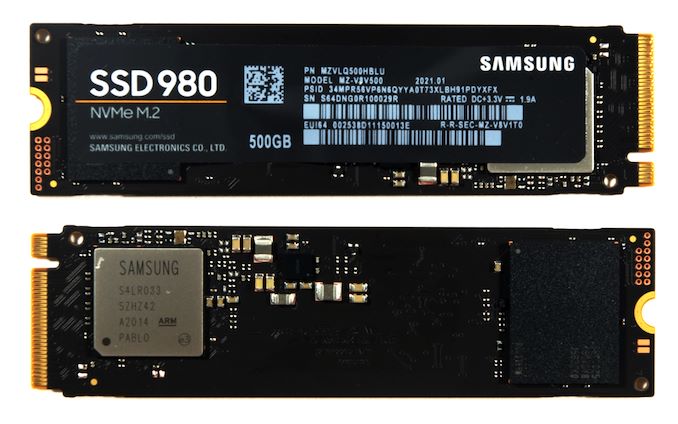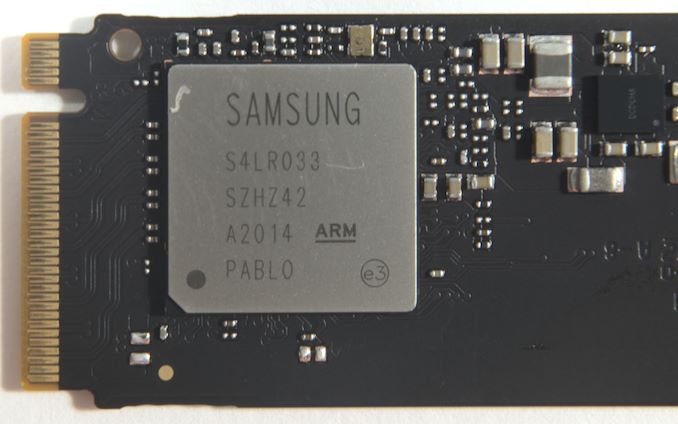How Much 4k Video Can 128gb Hold on Samsung S9
The new Samsung SSD 980 is the beginning retail-set up entry-level NVMe SSD from Samsung. Compared to previous SSDs from Samsung, it lacks any three-letter suffix at the end: it's non a PRO, nor an EVO, or even a QVO drive, because information technology doesn't fit into the established conventions for those product tiers. The SSD 980 slots into the production stacl at the bottom, but leaves a big enough gap for some other, maybe better, model to come in later. Samsung is marketing the SSD 980 as a successor to the 970 EVO.
Samsung's First Button into Entry NVMe at Retail
The SSD 980 is an entry-level NVMe SSD, using TLC NAND with a DRAMless controller. This makes it a new class of product for Samsung in the retail marketplace, one it has never produced before. This kind of drive, with TLC and without DRAM, is already prevalent in the market from other turn-key solution vendors, and this blazon of drive has been quite popular with OEMs: it allows them to annunciate a NVMe SSD without paying the cost of a high-end drive.

The new Samsung SSD 980 volition come in three capacities, 250 GB, 500 GB, and one TB. In this review we take the two highest capacities, featuring a Samsung custom controller and a variety of TLC NAND (explained more in detail below). As an NVMe bulldoze rated for PCIe 3.0 x4, meridian sequential read speeds are rated upward to three.5 GB/s for the 1 TB drive. The drives will be rated up to 0.3 drive writes per day (and then 300 GB/solar day on the one TB model) for v years.
| Samsung SSD 980 Specifications | |||||
| Chapters | 250 GB | 500 GB | one TB | ||
| Form Factor | Single-Sided M.ii 2280 | ||||
| Interface | PCIe 3.0 x4, NVMe ane.four | ||||
| Controller | Samsung Pablo | ||||
| DRAM | None | ||||
| NAND Flash | Samsung 128L 512Gb TLC | ||||
| Sequential Read | 2900 MB/s | 3100 MB/due south | 3500 MB/s | ||
| Sequential Write | 1300 MB/s | 2600 MB/s | 3000 MB/southward | ||
| Max SLC Cache Size | 45 GB | 122 GB | 160 GB | ||
| Random Read IOPS | QD1 | 17k | |||
| QD32T16 | 230k | 400k | 500k | ||
| Random Write IOPS | QD1 | 53k | 54k | ||
| QD32T16 | 320k | 470k | 480k | ||
| Power | Read | 3.7 W | 4.three W | iv.5 W | |
| Write | three.2 Westward | 4.two West | 4.6 W | ||
| Idle | 45 mW | ||||
| Idle (L1.ii) | 5 mW | ||||
| Warranty | 5 years | ||||
| Write Endurance | 150 TB 0.iii DWPD | 300 TB 0.3 DWPD | 600 TB 0.3 DWPD | ||
| MSRP | $49.99 (twenty¢/GB) | $69.99 (14¢/GB) | $129.99 (13¢/GB) | ||
The Samsung SSD 980 is congenital around its "Pablo" controller. This isn't actually a new NVMe controller, but it has has been aircraft in the Samsung Portable SSD T7 family for over a yr. This controller has half as many NAND channels as the controllers used in Samsung's high-end NVMe drives (iv rather than eight), and no DRAM interface. Using the loftier NAND IO speeds supported by recent generations of 3D NAND, the Pablo controller is able to saturate a PCIe 3.0 x4 host interface with out needing eight NAND channels.

The NAND is the same 512Gbit 128-layer 3D TLC institute on the 2TB 980 PRO. Lower capacities of the 980 PRO go the smaller 256Gbit 128L parts, but on the apparently SSD 980 Samsung is using the larger capacity die beyond all three bulldoze capacities. The smaller 980 PRO models need to use the smaller dies in social club to make full apply of the 8-channel controller, merely the plain 980 with a 4-aqueduct controller speed is less of a priority and the 512Gbit dies should exist slightly cheaper.
(Note: This review initially stated that Samsung was using 256Gbit 92L TLC on our 500GB SSD 980 sample and speculated that they were doing then on the 250GB model as well. Samsung has since confirmed that it's the 512Gbit 128L on all capacities, significant we misread a 0 equally a D in the NAND package role number.)
Updates with the SSD 980
With the SSD 980, Samsung has shifted to a more aggressive SLC caching strategy, more than tripling the maximum size of the cache every bit compared with the 970 EVO (Plus). They fabricated a similar shift with the 980 PRO. This is following a general industry trend toward larger SLC caches, almost noticeable on QLC NVMe SSDs, which helps improve performance on many benchmarks and some real-globe workloads. While good for operation numbers in brusque flare-up tests, it typically comes at the cost of operation when the enshroud fills upwards, or the bulldoze fills upwardly. For an entry-level drive that isn't intended for heavy workstation type workloads, this optimization toward peak performance makes a lot of sense.
Fifty-fifty though information technology'south a more than low-cease production than whatsoever of their previous NVMe SSDs, Samsung is still giving the SSD 980 a five-yr warranty with a 0.3 DWPD endurance rating, the aforementioned as all their recent EVO-tier drives.
A key office of Samsung plans to accomplish good existent-earth performance with the SSD 980 is the NVMe Host Memory Buffer (HMB) feature, which we have covered in depth in the past. In brief: the DMA capabilities of PCIe allow an NVMe SSD to efficiently access the CPU'due south main memory/DRAM. The NVMe host memory buffer feature allows the operating system to give the SSD a small-scale corporeality of DRAM to use for the SSD's own internal accounting. Functioning isn't as good as having DRAM on the SSD itself, and the amount of memory allocated is usually pretty small, default of effectually 64 MB but upwards to 1 GB, but information technology's enough to improve operation on a lot of real-earth workloads.
Assuming the drive's Flash Translation Layer has a typical pattern, a HMB of 64 MB is enough to cache the logical to physical accost mappings for most 64GB of storage. That's a very tiny amount of host RAM, just 64 GB of storage is a lot more than typical consumer workloads need to actively use at one time. The key part here is 'in employ' - the HMB will just fill (and aggrandize) equally information is used in the bulldoze for that session. So even though a summit game might be 250 GB to install, it might only use l GB to play on a particular level.
| NVMe Host Retention Buffer Sizes | ||
| Minimum | Default | |
| Samsung 980 | 16 MB | 64 MB |
| WD Blue SN550 | 3 MB | 32 MB |
| Mushkin Helix-L | 32 MB | 64 MB* |
| Toshiba RC100 | 10 MB | 38 MB |
The Samsung SSD 980 requests 64 MB of host ram for its HMB, merely is willing to brand employ of as footling equally 16MB. These values are similar to other DRAMless NVMe SSDs we've tested. For this review, we've run the synthetic benchmarks with HMB enabled (the default on recent operating systems) and with HMB disabled to illustrate its touch on.
The exception is the Mushkin Helix-Fifty with the Silicon Motion SM2263XT controller: we didn't meet any significant performance differences between HMB on and HMB off even on tests designed specifically to illustrate the issue of HMB, so information technology's pretty articulate that drive'due south firmware never gets around to actually using the 64MB it asks for.
Samsung and Entry Level: The History
Historically, Samsung has distanced itself from making true entry-level drives for the retail SSD market, preferring to hold onto some caste of premium status and retain a more comfortable profit margin. This is a strategy that it'south vertical integration has supported very well.
Samsung has covered some of the low-terminate earlier however, with the QLC QVO SATA SSDs. But even here, Samsung has retained slightly premium prices, and then the main appeal has been how affordable these drives are at the extremely large capacities. Samsung has not yet brought QLC NAND to their consumer NVMe product line, so the other obvious formula for a low-cease drive is to go DRAMless while sticking with TLC NAND.
The pause from Samsung'due south typical PRO/EVO/QVO split is not entirely without precedent: in the past there accept been a few other occasions where Samsung has needed an actress product tier, resulting in the 750 EVO and SSD 850. Since then, Samsung has added the QVO tier of products, but the 980 doesn't authorize because information technology's using TLC NAND rather than QLC. Samsung also doesn't have room to decrement any office of the model number since there's no gap left between their 800-series SATA SSDs and 900-serial NVMe. So we're left with the obviously 980 while Samsung keeps a spot open for a ameliorate 980 EVO.
The Competition
Nosotros weren't able to review the WD Blue SN550 when it launched at the end of 2019, but we obtained a sample to include in this review because the SN550 is the about important competitor to the Samsung SSD 980. The before WD Blueish SN500 significantly raised the bar for DRAMless SSDs, and the SN550 improves on it in almost every way. The Samsung SSD 980 is rated for much higher peak performance on sequential and random IO, only for more real-world workload the SN550 won't be and so piece of cake to beat. We too have results from the older Mushkin Helix-L, though with evidently inoperative HMB support it's nowhere near as competitive. As well in the low-cease NVMe market segment nosotros accept a pair of QLC drives: the Corsair MP400 with the 8-channel Phison E12 controller, and the Intel SSD 670p with the new Silicon Motion SM2265 controller.
In the more than mainstream TLC NVMe market segment, the drive to keep an eye on is the SK hynix Gold P31. Like the Samsung SSD 980 it uses a four-aqueduct controller, but the P31 has the usual full amount of on-board DRAM which makes it a higher class of drive. If Samsung releases a 980 EVO in the near time to come, it will about certainly go after the P31'due south position in the market, though Samsung may also attempt for a slight performance advantage past including PCIe gen4 support.
We also have results from several other recent Samsung SSDs in different market segments: the 870 EVO TLC SATA, 970 EVO Plus high-stop PCIe Gen three, and 980 PRO high-stop PCIe Gen 4. The latter was re-tested with updated firmware a few weeks ago, but we didn't find whatsoever notable operation changes with our test suite.
Trace Tests: AnandTech Storage Demote and PCMark ten
Source: https://www.anandtech.com/show/16504/the-samsung-ssd-980-500gb-1tb-review
0 Response to "How Much 4k Video Can 128gb Hold on Samsung S9"
Post a Comment